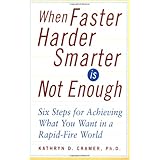
Average Reviews:

(More customer reviews)Are you looking to buy When Faster Harder Smarter Is Not Enough : Six Steps for Achieving What You Want In a Rapid-Fire World? Here is the right place to find the great deals. we can offer discounts of up to 90% on When Faster Harder Smarter Is Not Enough : Six Steps for Achieving What You Want In a Rapid-Fire World. Check out the link below:
>> Click Here to See Compare Prices and Get the Best Offers
When Faster Harder Smarter Is Not Enough : Six Steps for Achieving What You Want In a Rapid-Fire World ReviewWhat happens to enormously capable people when they are vastly overloaded with work? In too many cases, these individuals will focus all their energies on work, while building intense stress loads that reduce their effectiveness. The result is either failure to get the job done or eventual burnout. The personal lives of those involved are often left in total disarray in the process.Dr. Cramer instead suggests that you step back and find a new solution that does not rely on working faster, harder and smarter. For example, ask yourself whether the task needs to be done at all. Often, the overwhelming task is a waste of time. A good example would be marketing programs that primarily bring in unprofitable customers.
In this interesting book, Dr. Cramer emphasizes ways to manage your psychological state that will help you step outside the day-to-day tasks to establish an effective strategy for accomplishing what you really want. When Faster, Harder, Smarter Is Not Enough is intended to be your coach and personal guide to "enlarge our capacity to be creative under fire." As a result, you will turn "stress into success" and be "energized rather than drained."
Her advice is supported by case histories from her executive coaching practice over 20 years, and exercises to help you build awareness and skills for being more creative. One of the most interesting ones is building a life map to see your patterns for getting into and out of overload situations. The book contains a continuing case history of a CEO who got out of touch with his real goals, and wanted to change. This example also shows the many ways that these methods can be employed throughout an organization.
She emphasizes 6 elements:
(1) " . . . see the big picture (externally) and . . . be aware of your emotional landscape (internally)." To do this, she encourages you to be curious and committed, while being intuitive and aware.
(2) " . . . imagine the best possible outcome and . . . become energized by how excellent it is."
(3) " . . . concrete yet flexible plan for achieving your goal, and . . . give up any counterproductive ideas or habits that might sabotage your efforts." This requires being imaginative, visionary, observant, and innovative.
(4) " . . . involve in your game plan those you love and those you need." Here you need to be influential and collaborative, articulate and persuasive.
(5) " . . . implant your plan, watch your progress, overcome the obstacles that present themselves, and learn to capitalize on conflict." Here, you are trying to be resilient and resourceful, fearless and authentic in your actions.
(6) "Enjoy your achievements . . . and do it all over again!" To do this, be passionate, proactive, inspired and confident.
You start with developing a list of long-term personal and professional goals, " . . . then connect the dots." You will do this by becoming richer in mental and emotional resources, deeper in your thinking, and wiser in your choices. You will also become better at avoiding your deepest habits of harmful blind reaction.
Having co-authored a book on developing better decision-making and action habits, I found this approach to creating the right psychological environment for such changes to be very interesting. I thought that points two and four above are important, and are often forgotten in the rush to accomplish. I suspect that the best use of this book is in combination with any of the many excellent books about how to become more creative, to add more focus into the psychological space that this book creates. Without more specific content on the technology of creating these solutions, those who employ this book will create better solutions . . . but ones that I suspect are much less than their full potential to achieve through their organizations.
After you finish exploring these more resourceful states, I encourage you to think about how you allocate your time. Breaking patterns of where you spend too much time that is not supportive of your real intentions is a great way to get started!
Always spend time to think through the questions of whether the work needs to be done, how it can be done vastly better, and how you can get enormously greater results from the same effort. The more overwhelming the situation seems, the more important it is to do this!
When Faster Harder Smarter Is Not Enough : Six Steps for Achieving What You Want In a Rapid-Fire World Overview
Want to learn more information about When Faster Harder Smarter Is Not Enough : Six Steps for Achieving What You Want In a Rapid-Fire World?
>> Click Here to See All Customer Reviews & Ratings Now
0 comments:
Post a Comment